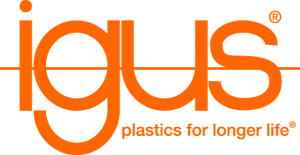 While Germany-based company igus GmbH is well-known for its linear guides, motion stages, bearings, and e-chains and plastic guides to protect cables, it also does a decent amount of business in the 3D printing industry. In addition to polymer materials and specialized filaments, such as its lubrication-free iglidur for making smooth industrial components, the company also offers its own online 3D printing service, so that customers can purchase models made out of its materials. Parts from the company were also used by members of FabLab Karlsruhe to manufacture the delta-style Hexagon V2 3D printer.
While Germany-based company igus GmbH is well-known for its linear guides, motion stages, bearings, and e-chains and plastic guides to protect cables, it also does a decent amount of business in the 3D printing industry. In addition to polymer materials and specialized filaments, such as its lubrication-free iglidur for making smooth industrial components, the company also offers its own online 3D printing service, so that customers can purchase models made out of its materials. Parts from the company were also used by members of FabLab Karlsruhe to manufacture the delta-style Hexagon V2 3D printer.
“What we have here is a company that is leapfrogging entire segments and verticals in industry,” 3DPrint.com’s Editor-in-Chief Joris Peels said about igus back in August.
igus got its start as a polymer company, and later added services like assembled injection molded parts, bearings and guides, and making chains, before getting into 3D printing by doing things like custom building a motion stage for a particular 3D printer. At the time the Hexagon V2 came out, it seemed unlikely that igus would manufacture and sell its own 3D printer. But things change.
The company is now working to make high temperature 3D printing systems more accessible to people who are new to the technology. igus just developed and built its own version, and is now teaching others how to make it as well by making all of the CAD data and STL files for the 3D printer available for free download.
Tom Krause, head of the additive manufacturing division at igus, said the company’s new build-it-yourself system is “A nice example of our low-cost design concept.”
It wasn’t too long ago that high temperature 3D printers weren’t even on the market, though that’s definitely no longer the case. These systems can be used for high-performance materials such as PEEK, PEKK, and PEI, which are notoriously hard to print. This means the potential market for high temperature systems is great, as these materials could potentially replace metal. However, they’re not cheap and they’re very difficult to make. That’s why igus is working to make high temperature 3D printing more accessible by making the CAD data for its new system available.
The igus 3D printing team wanted to make low-cost design a reality in the factory environment, which is why it decided to create a cost-effective, high temperature 3D printer that can be made using in-house mechanical engineering components.
According to an igus blog post by Sven Weber, this new system is “A self-built 3D high temperature printer based on drylin W rail guides and dryspin steep-thread spindle made of stainless steel in combination with spindle nuts made of high-temperature resistant iglidur materials.”
For those interested in building this printer, igus suggests using the complete linear systems – made of low-noise drylin W linear guides, dryspin steep threads, and igus stepper motors – from its standard range. You can download the technical design data to make your own high temperature 3D printer here.
Please note, there is a disclaimer at the end of the blog post that reads:
“The models and drawings provided here are an example of the use of various igus components in a high temperature 3D printer or in a high-temperature application. A legally binding assurance of certain properties or the suitability for a certain application cannot be derived. igus assumes no liability for damages resulting from the application of the models, drawings and products. Accordingly, no support is offered for the construction of this 3D printer, as igus is not a manufacturer of 3D printers.”
The company’s high-temperature 3D printer also supports the development of new materials. This means that users can make maintenance- and lubricant-free filaments, out of high-performance plastics iglidur J350 and RW370, that can be used to produce heat-resistant components.
Will you try and make your own high temperature 3D printer? Let us know! Discuss this story and other 3D printing topics at 3DPrintBoard.com, or share your thoughts in the Facebook comments below.
Subscribe to Our Email Newsletter
Stay up-to-date on all the latest news from the 3D printing industry and receive information and offers from third party vendors.
Print Services
Upload your 3D Models and get them printed quickly and efficiently.
You May Also Like
The Market and Industry Potential of Multi-Material 3D and 4D Printing in Additive Electronics
Additive manufacturing leverages computer-based software to create components for products by depositing either dielectric or conductive materials, layer by layer, into different geometric shapes. Since its birth in the 1980s,...
3DPOD 262: Bio-inspired Design for AM with Dhruv Bhate, Arizona State University
Dhruv Bhate is an associate professor at Arizona State University. There, he looks at structures, materials, and design. Previously, he worked at PADT as well as in the semiconductor and...
3DPOD 261: Tooling and Cooling for AM with Jason Murphy, NXC MFG
Jason Murphy´s NXC MFG (Next Chapter Manufacturing) is not a generalist service; instead, the company specializes in making tooling. Using LPBF and binder jet, the company produces some of the...
3DPOD 260: John Hart on VulcanForms, MIT, Desktop Metal and More
John Hart is a Professor at MIT; he´s also the director of the Laboratory for Manufacturing and Productivity as well as the director of the Center for Advanced Production Technologies....


































